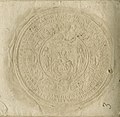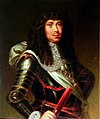Michał Korybut Wiśniowiecki
| Michael I | |
|---|---|
Lwów, Polish–Lithuanian Commonwealth | |
| Burial | 31 January 1676 |
| Spouse |
Eleonora Maria of Austria (m. 1670) |
Roman Catholicism | |
| Signature | |
Michael I (Polish: Michał Korybut Wiśniowiecki, Lithuanian: Mykolas I Kaributas Višnioveckis; 31 May[1] 1640 – 10 November 1673) was the ruler of the Polish–Lithuanian Commonwealth as King of Poland and Grand Duke of Lithuania from 29 September 1669 until his death in 1673.[2]
Michael was chosen partly because of the merit of his father, prince
In 1670 Michael I was married to
Biography

Michael was the son of
The wedding took place in Zamość on 27 February 1639, and over a year later, on 31 May 1640, Michael Korybut was most likely born in the village of Biały Kamień as Michał Tomasz Wiśniowiecki. The infant was then taken to Zamość, where he spent first two years of his life under care of his grandmother Katarzyna Zamoyska (née Ostrogska). In 1642, Michał was taken by his mother to Lubny. During the Khmelnytsky Uprising, he fled Left-bank Ukraine with his family and first settled in Wiśniowiec in Volhynia, before arriving in Zamość in autumn 1648.

Jeremi Wiśniowiecki died in 1651, when most of his enormous estate remained under Cossack or Russian control. From 1651 – 1655, young Michał was under the care of
Following the Swedish invasion of Poland, Michael, together with the royal court, fled to Głogówek in Upper Silesia. On 18 November 1655, following the request of the king, he went to Nysa, to study at the Jesuit College Carolinum and stayed there until March 1656.
In mid-1656, thanks to the support of Queen
In 1663, Michel took part in the
Election
On 16 September 1668,
The
His election was immediately opposed by the pro-French camp, led by
On 27 February 1670 Michael I married Austrian princess
Internal conflicts

Following the 1669 election, the Commonwealth was divided between two camps – pro-French, and royal. The pro-French camp had several influential members, including Primate Prazmowski, Hetman Sobieski,
In November 1669, the French camp broke the Coronation
To make matters worse, the divided Commonwealth was under constant Turkish threat. In 1671, the king supported a rebellion of a unit of Stanisław Wyżycki, who, against the explicit order of Sobieski, abandoned Volhynia, leaving the province defenceless. King Michael ordered Wyżycki and his men to spend the winter of 1671/72 in the wealthy starostwo of Sambor, and paid them their salaries, while Sobieski and his soldiers did not receive any money.

In 1672, the Ottoman Empire declared war on the Commonwealth, and the
Negotiations between the two factions were carried out by Papal Nuncio Francesco Buonvisi and Bishop of Kraków Andrzej Trzebicki. Furthermore, Sultan Mehmed IV of the Ottoman Empire sent an offensive letter to Warsaw, demanding complete subordination of the Commonwealth. This greatly enraged the Poles but due to chaotic internal situation of the Commonwealth, both sides of the conflict reached an agreement in March 1672.
War with the Ottoman Empire
In June 1672, a 100,000-strong Ottoman army, under Mehmed IV, besieged the city of
In October 1672, Hetman John Sobieski, upon request of the senators, tried to stop the invaders, defeating them in the
Soon afterwards, Michael I began preparation for a new military campaign against the Ottomans. On 8 October 1673 at Skwarzawa near
Death, funeral, and legacy

King Michael I Korybut died in the Palace of the Archbishops of Lwów, on 10 November 1673. His early demise seems to have been brought about by a severe case of food poisoning, although rumours persisted that he had been murdered by traitorous generals angered at the declining power of the Commonwealth.
The day after his death, John Sobieski won the
After the funeral, the heart of the king was buried at a Camedule Monastery in the
Michael's reign was considered to be less than successful as his ability to be a capable monarch were greatly hurt by Poland's quarrelling factions. His father's military fame notwithstanding, Michael lost the first phase of the Polish–Ottoman War of 1672–1676.[4]
Gallery
-
King Michael I Korybut by Jan Matejko
-
Portrait byBacciarelli
-
Coronation mantle of Michael I Korybut
-
Battle of Chocim on 11 November 1673
-
Seal of Grand Duchy of Lithuania (1671), used during Michael's reign
-
Anonymous portrait of Micheal I, 18th century
Royal titles

- Official Latin version: Michael I, Dei Gratia rex Poloniae, magnus dux Lithuaniae, Russiae, Prussiae, Masoviae, Samogitiae, Livoniae, Smolensciae, Kijoviae, Volhyniae, Podoliae, Podlachiae, Severiae, Czernichoviaeque, etc.
(citation from one contemporary document: "Michael primvs, Dei gratia rex Poloniae, magnus dvx Lituaniae, Russiae, Prussiae, Masouiae, Samogitiae, Kiiouiae, Volhyniae, Podlachiae, Podoliae, Liuoniae, Smolensciae, Seueriae Czernihouiaeque etc")
- English translation: Michael I, by the Grace of God, King of , etc.
See also
- History of Poland (1569–1795)
- Wiśniowiecki family
References
- ^ Ilona Czamańska, Wiśniowieccy. Monografia rodu, Poznań 2007, p .249,
- ^ Lerski Historical Dictionary of Poland, 966–1945 1996 -p654 "In the seventeenth century, members of the family held the most important posts in the Polish–Lithuanian Commonwealth,* and Michal Korybut Wisniowiecki* was elected King of Poland"
- ^ "Michael Wisniowiecki – biography – king of Poland". Encyclopædia Britannica. Retrieved 5 November 2015.
- ^ Poczet.com, Michał Korybut Wisniowiecki.
- ^ www.wladcy.myslenice.net, Michał I Tomasz Wiśniowiecki herbu Korybut.
External links
![]() Media related to Michał Korybut Wiśniowiecki at Wikimedia Commons
Media related to Michał Korybut Wiśniowiecki at Wikimedia Commons



![Clementinum in Prague, where he studied[5]](http://upload.wikimedia.org/wikipedia/commons/thumb/7/74/Prague_clementinum_entrance.jpg/82px-Prague_clementinum_entrance.jpg)




